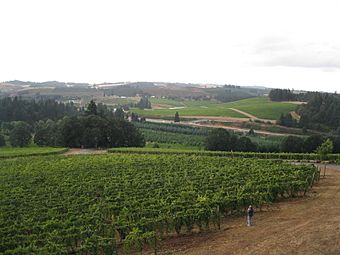Willamette Valley AVA facts for kids
| Wine region | |

Willamette Valley
|
|
| Type | American Viticultural Area |
|---|---|
| Year established | 1984 |
| Years of wine industry | 1965–present |
| Country | United States |
| Part of | Oregon |
| Sub-regions | Chehalem Mountains AVA, Dundee Hills AVA, Eola-Amity Hills AVA, McMinnville AVA, Ribbon Ridge AVA, Van Duzer Corridor AVA, Yamhill-Carlton District AVA |
| Climate region | Maritime |
| Soil conditions | Volcanic origin and weathered sedimentary loam |
| Total area | 5,360 square miles (3,430,400 acres) |
| Grapes produced | Auxerrois, Cabernet Franc, Cabernet Sauvignon, Cascade, Chardonnay, Dolcetto, Gamay noir, Gewurztraminer, Malbec, Marechal Foch, Melon, Merlot, Müller-Thurgau, Muscat Canelli, Muscat Ottonel, Pinot blanc, Pinot gris, Pinot noir, Riesling, Sauvignon blanc, Syrah, Tocai Friulano, Viognier |
| No. of wineries | 500 |
The Willamette Valley AVA (pronounced wi-LAM-it) is a special area in Oregon, USA. AVA stands for American Viticultural Area. This means it's a recognized region known for growing grapes and making wine.
The Willamette Valley AVA covers the area around the Willamette River. It stretches from the Columbia River in the north to just south of Eugene. To the west, it reaches the Oregon Coast Range, and to the east, the Cascade Mountains.
It's the largest AVA in Oregon, covering about 5,360 square miles (13,882 square kilometers). Many of Oregon's wineries are found here. The Willamette Valley has a cool and moist climate. It is famous around the world for its Pinot noir wine. The Willamette Valley AVA was officially created in 1984.
Contents
Climate and Vineyards
The weather in the Willamette Valley is mild all year. Winters are usually cool and wet. Summers are dry and warm. Temperatures rarely go above 90°F (32°C). It almost never drops below 0°F (-18°C).
Most of the rain falls in late autumn, winter, and early spring. The valley gets a small amount of snow each year, usually between 5 to 10 inches (13 to 25 cm).
Not all parts of the valley are good for growing grapes. Most wineries are located west of the Willamette River. They are often on the slopes of the Coast Range. Many are also found in the smaller valleys created by the Willamette River's branches. The largest number of wineries is in Yamhill County.
Smaller Wine Regions
Inside the Willamette Valley AVA, there are seven smaller American Viticultural Areas. These smaller AVAs are special because they have unique features. These features can include different climates, types of soil, or elevations. These differences make them especially good for making certain types of wine.
Chehalem Mountains AVA
The Chehalem Mountains AVA was created in 2006. It stretches about 20 miles (32 km) from Wilsonville to Forest Grove. This area includes places like Ribbon Ridge, Parrett Mountain, and Bald Peak.
Dundee Hills AVA
The Dundee Hills AVA is located in the hills near Dundee. This area is known for its Pinot noir wine. Many wineries here have won international awards for their wines.
Eola-Amity Hills AVA
The Eola-Amity Hills AVA runs from Amity in the north to Salem in the south. This area gets cool, steady winds from the Pacific Ocean. These winds come through a gap in the Oregon Coast Range called the Van Duzer corridor. These winds help keep the summer temperatures mild. The name "Eola" comes from Aeolus, the Greek god of wind.
McMinnville AVA
The McMinnville AVA was established in 2005. It is located in the hills southwest of McMinnville. This AVA includes vineyards at elevations from 200 to 1,000 feet (61 to 305 meters).
Ribbon Ridge AVA
The Ribbon Ridge AVA is a narrow ridge between Newberg and Gaston. It is made of uplifted ocean sediment. The ridge is about 0.25 miles (0.4 km) wide and 3.5 miles (5.6 km) long. It has about 500 acres (2 square kilometers) of grapes planted across 20 vineyards.
Van Duzer Corridor AVA
The Van Duzer Corridor AVA was established in 2019. It is west of the Eola-Amity Hills AVA. This area is known for its low hills and cool breezes from the Pacific Ocean. The soil here is mostly made of marine sediments.
Yamhill-Carlton District AVA
The Yamhill-Carlton District AVA is around the towns of Yamhill and Carlton. Only grapes grown in vineyards between 200 and 1,000 feet (61 to 305 meters) high can use this name on their wine labels. This area is in a "rain shadow" because the 3,500-foot (1,067-meter) Oregon Coast Range blocks much of the rain.


